
Good Morning.
I will be taking care of all your problems today. So sit back, relax, and enjoy the rest of your day!
-God
This is what the sign on the wall read at the Salvation Army on the North side of Chicago. Prior to volunteering there, I only knew stereotypes of the homeless and hungry…just what you see on TV. But it didn’t take long for those stereotypes to break down. The people we served meals to were happy, smiling, polite and full of energy. What surprised me most, was their deep sense of spirituality. Not only did I find this in my conversation with folks, but even in their greeting. My standard, “Good morning, how are you?” was often replied with “Blessed” or “In His Grace”, many with bible in hand.
I used to wonder, how could people so hard on their luck, have so much faith? I have seen so many times with family and friends, after they’ve suffered difficult circumstances or loss, God and religion are the first things questioned, i.e. “How could God do this to me?”
Many students face physical and psychological bullying in schools- elementary, middle, and high. But Sikh students, male and female, often face especially severe bullying. Over the past couple years, some severe cases have come into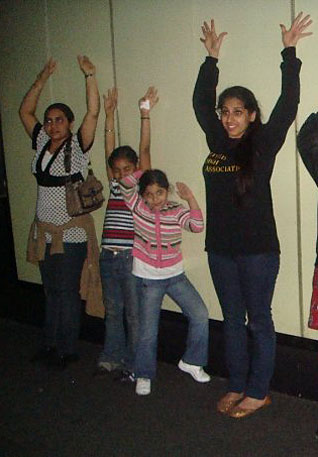 the public eye, including one teenager’s patka being set on fire, and others whose hair was forcibly cut. For statistics on the prevalence of harassment against Sikh students in New York schools, check out the Coalition’s report, “Hatred in the Hallways.”
the public eye, including one teenager’s patka being set on fire, and others whose hair was forcibly cut. For statistics on the prevalence of harassment against Sikh students in New York schools, check out the Coalition’s report, “Hatred in the Hallways.”
One pro-active student at Baruch College (of the City University of New York) has come up with a simple and creative way to provide support to kids facing harassment. Through his school’s Sikh Student Association, he started a mentoring program called Sikh Scouts. The students, aged 5-12 are paired with older Sikhs of the same gender, and go on a day’s outing together.
Sikh Scouts is essentially a small-scale Sikh youth mentoring event that aims to forge and develop a long-lasting relationship with children in need of good Sikh role models to help them guide them on the path of Sikhi. [link]
One of the students from Baruch that participated in the program wrote about the experience.
After they warmed up to us and broke through their initial shyness, the kids couldn’t stop talking about their favorite movies, TV shows and music – the Jonas Brothers and what not. And in between all of that, we got down to the serious issues: a majority of the kids did not enjoy school and felt uncomfortable because of harassment or teasing by their peers. [link]
There might not be much that anyone, including the older Sikh Scouts, can do to make the bullying stop- after all, kids will be kids. But what we older Sikh students can do for our younger counterparts is to be a source of strength, share insights about why it’s important to be comfortable with who you are whether it fits someone else’s definition of cool or not, and be there to offer advice for specific situations. There are things we’ve learned in hindsight that can benefit those facing the same harassment today.
 As someone who considers herself honorary Peruvian (it’s a long story) – I was especially proud when I heard about Operation Walk – an organization established by Harpal Singh Khanuja and his wife Maria Khanuja. The non-profit organization is dedicated to providing free knee and hip replacements to underserved people around the world. The concept behind the organization was to perform complicated surgeries on people in developing countries, “where arthritis progresses to its end stages and reconstructing joints becomes technically challenging.” Often times, it is people who are most at need who cannot afford the surgery. A news article discusses Operation Walk’s recent trip to Lima, Peru where they performed 48 surgeries to replace knee and hip joints. Here on TLH we like to highlight examples of seva – this is another important example of what it means to do selfless service,
As someone who considers herself honorary Peruvian (it’s a long story) – I was especially proud when I heard about Operation Walk – an organization established by Harpal Singh Khanuja and his wife Maria Khanuja. The non-profit organization is dedicated to providing free knee and hip replacements to underserved people around the world. The concept behind the organization was to perform complicated surgeries on people in developing countries, “where arthritis progresses to its end stages and reconstructing joints becomes technically challenging.” Often times, it is people who are most at need who cannot afford the surgery. A news article discusses Operation Walk’s recent trip to Lima, Peru where they performed 48 surgeries to replace knee and hip joints. Here on TLH we like to highlight examples of seva – this is another important example of what it means to do selfless service,
“It was very rewarding to do this work for people and not expecting anything in return,” Harpal Singh said. “It’s really their gratitude that you cherish the most.”
The organization’s goal is to replicate the Peru mission to Panjab where the need is also great (some of which can be attributed to the chemical farming of the Green Revolution).
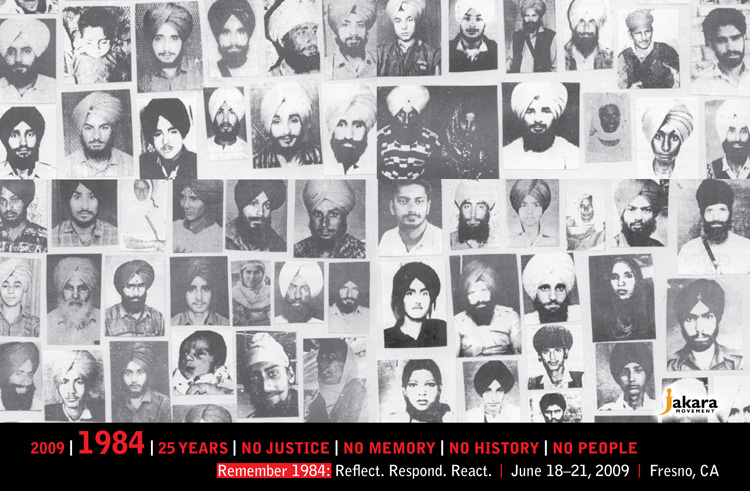
The topic of 1984 is hardly new in The Langar Hall and despite protestations from some amnesia-desiring commenters, we will not forget the Shaheeds of Darbar Sahib, the pograms in Delhi, the Ghallughara against the Sikhs from 1978-1995, or even the continuing impunity that continues today.
We have highlighted many events in the past and we will contine to do so.
In that spirit, I strongly urge TLH readers to attend this year’s Jakara Movement conference in Fresno, CA from June 18-21st. A number of invited guests’ names will be announced in the upcoming week. The title of the conference is “Remember 1984: reflect. respond. react.”
2009 | 1984 | 25 years | No justice | No memory | No history | No people
Despite the fact that many wish to forget the events that befell and have shaped the Sikh Nation, it is vital for the ‘next generation of Sikhs’ to be aware of our past and understand how it shapes our present and our future. While twenty-five years have passed since the attack on our sacred home, much has changed and much has remained the same. For the Nishan Sahib of our Nation to remain tall, it is for us to study our history, remember the past, and continue the fight for justice.
This year at Jakara, we will Remember 1984 and celebrate those Kaurs and Singhs that made the ultimate sacrifice for our Qaum.
Join us in Fresno as we Remember 1984: Reflect. Respond. React.
Register here TODAY and avoid a late fee. Below the fold you’ll find the agenda. See you there!
Gatka owes its early development to the Shaster Vidiya, literally meaning knowledge of the arms. This was a warrior curriculum used by the Sikhs for military training. [link]
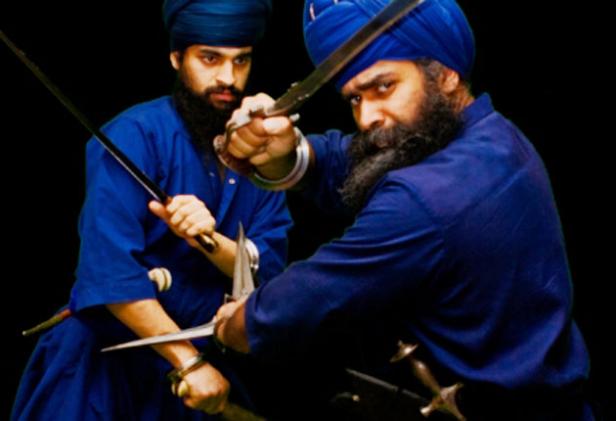 A fascinating article in a UK newspaper highlights the return of Shaster Vidiya – the “world’s original martial art” which was banned by the Raj after the final defeat of the Sikh empire in the mid-19th century. Considered a forgotten art form, Shastar Vidiya was practiced in North India before the emergence of Sikhism. However, it was the Sikhs who were known to have fully mastered this particular fighting style.
A fascinating article in a UK newspaper highlights the return of Shaster Vidiya – the “world’s original martial art” which was banned by the Raj after the final defeat of the Sikh empire in the mid-19th century. Considered a forgotten art form, Shastar Vidiya was practiced in North India before the emergence of Sikhism. However, it was the Sikhs who were known to have fully mastered this particular fighting style.
Now, it seems, young British Sikhs are attempting to revive this lost art form. Their teacher, a controversial figure named Nidar Singh Nihang, has been studying the art of Shastar Vidiya for the past 20 years in hopes of passing it onto the younger generation. Students begin learning how to fight with simple wooden sticks. However, those who show a particular skill and dedication are allowed to practice with the kind of swords that once made the Sikh armies so powerful. The article points out the irony of a British Sikh trying to resurrect shastar vidiya given the history,
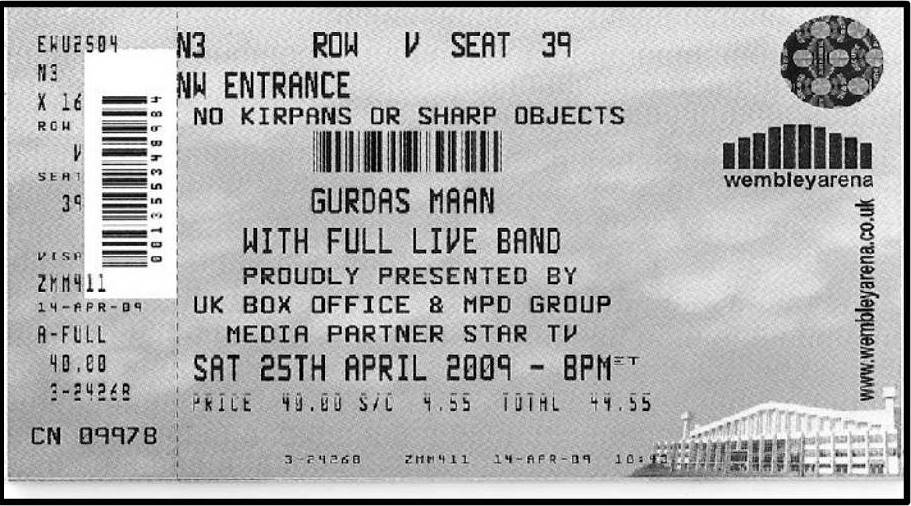
Vaisakhi in the diaspora usually brings two things to those living in cities with large Sikh communities: Nagar Kirtans and Vaisakhi concerts. Unfortunately, if you were an Amritdhari Sikh in London this year and you wanted to partake in both, you would have been out of luck. Tickets for the recent Gurdas Maan concert held at Wembley Arena had a unique warning printed on them, “NO KIRPANS OR SHARP OBJECTS”.
I won’t dwell too much on the irony of banning kirpans at a Vaisakhi concert, which usually start with the requisite dharmak songs, like Gurdas Maan’s tribute to Guru Gobind Singh and his contributions to Sikhi.
What I wonder is exactly what the organizers must have been thinking in doing this. I suspect the banning of kirpans probably falls under generic security rules banning knives and other weapons. In fact the terms and conditions on their website state that the “possession of any article, which is or may be used as a weapon or missile” is strictly prohibited. Pretty standard fare at all large venues.
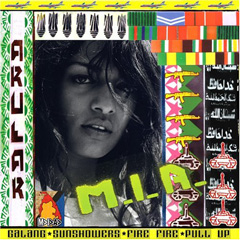 Months ago, my fellow langa(w)r-iter asked a question “On Whose Watch?” when Russian tanks retaliated against Georgian incursions. However, and almost all of us here at TLH, I believe, fall into the trap of having an American filter in terms of the news we discuss and don’t discuss have certainly left out a human rights travesty much closer to South Asia – that of Sri Lanka.
Months ago, my fellow langa(w)r-iter asked a question “On Whose Watch?” when Russian tanks retaliated against Georgian incursions. However, and almost all of us here at TLH, I believe, fall into the trap of having an American filter in terms of the news we discuss and don’t discuss have certainly left out a human rights travesty much closer to South Asia – that of Sri Lanka.
Another Sikh writer, Amardeep of Sepiamutiny, recently wrote about the ongoing humanitarian crisis, but as most in the media, in his subsequent comments, takes a statist approach. I believe that many Sikhs, from their own perspectives on state-violence against non-state actors, take a more even-handed view.
The humanitarian crisis is on epic proportions. A recent article by Gareth Evans, president of the International Crisis Group, writes:
As the Sri Lankan army continues its assault on what is left of the separatist Liberation Tigers of Tamil Eelam (LTTE), tens of thousands of civilians remain trapped inside a shrinking conflict zone, at risk not only from the fighting but from starvation and lack of water and medical attention. Despite the government’s April 27 announcement that the military had been ordered to cease using air attacks, artillery, and other heavy weapons against remaining LTTE-held areas, such attacks have carried on with increased intensity.
The trapped civilians are not the only ones at risk. More than 170,000 who have managed to escape the worst of the fighting remain imprisoned in desperately overcrowded camps and medical centers. Scores are reported to have died after fleeing the conflict zone, and the military has been overwhelmed by the number of civilians flooding into reception areas.
Regardless of one’s opinion of the LTTE and their horrific tactics, I would hardly condone a terrorist state, whose own violence and discriminatory practices led many Tamils into the arms of Prabhakaran and others of the LTTE. The LTTE does/did represent the voice of many Tamils.
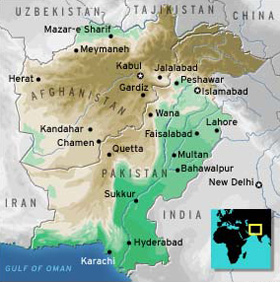
There were two blurbs in the news this week regarding the ethnic cleansing of Sikhs from Pakistan’s tribal regions along the Afghani border [full disclaimer: both stories are from the Indian press, so there is certainly a different political interest/stake in representing Pakistan as a state with anti-minority insurgency]:
Terming the Taliban as “ruthless killers,” the US today said the action initiated by them against the minority Sikh community in Pakistan’s tribal region was not surprising provides all the more reason to rid the region of extremists.
“I’ve heard reports about that. It doesn’t surprise me. I mean, these are ruthless killers, the Taliban,” State Department spokesman Robert Wood told reporters at his daily press briefing when asked about Taliban’s demand for “Jizya” from Sikhs in Pakistan’s tribal regions forcing them to leave their homes. [link]
India has taken up with Pakistan the issue of treatment of minorities following reports of demolition of Sikhs’ homes in parts of the country. [link]
I fully appreciate the irony of India calling for Pakistan to pay attention to the violent removal of minorities from their homes, and the spillover effects of the Taliban’s activities on the Pakistani border have been well-covered in the media. But this raises a larger question about more bald-faced attempts to crowd Sikhs and other religious minorities fully out of Pakistan. Sikhs already constitute a super thin minority with very little political power. Some would argue this should come as no surprise if people chose to remain within an Islamic Republic. Nonetheless, this additional pressure places an additional strain on minority communities who have negotiated remaining within Pakistan. Does this indicate Pakistan’s overall weakness in enforcing its border, or does it illustrate a political decision not to get involved while the Taliban capitalizes on underlying beliefs around minority groups? As this culture of intolerance moves east, is it the harbinger for a larger cultural shift within Pakistan? It certainly calls for the homogenization of the State, including forms of practice within Islam, but was this an interim sacrifice in order to preserve primacy for the central government?
 Go to virtually any diasporan Sikh’s house that has an interest in Sikhi and you will find the ubiquitous blue book. On the cover is a dashing picture of Shaheed Jarnail Singh Ji Khalsa Bhindranwale. The title: Fighting For Faith and Nation: Dialogues with Sikh Militants. While too few Sikhs actually complete the book to those that are patient and willing, anthropologist Cynthia Keppley Mahmood explores the world of Sikh militants through their own voices, allowing them to air the very humanity that continues to be denied by a totalitarian state machinery.
Go to virtually any diasporan Sikh’s house that has an interest in Sikhi and you will find the ubiquitous blue book. On the cover is a dashing picture of Shaheed Jarnail Singh Ji Khalsa Bhindranwale. The title: Fighting For Faith and Nation: Dialogues with Sikh Militants. While too few Sikhs actually complete the book to those that are patient and willing, anthropologist Cynthia Keppley Mahmood explores the world of Sikh militants through their own voices, allowing them to air the very humanity that continues to be denied by a totalitarian state machinery.
At a time when even too many Sikh authors and scholars were silent as Dr. Mahmood, herself, laments:
“Sikh Studies,” a traditionally Orientalist field that has consciously steered clear of the topic of conflict in Punjab, even as tens of thousands of Sikhs perished, wants us to look at medieval religious texts while the heart of Sikhism is in flames. If we touch the fire, if then too we burn and say ouch! – then we are shunned. But then again, academia has never done well in perilous times.
The Sikhs found two strong voices who I call our Sikh Bibiyan of the Academy – Joyce Pettigrew and Cynthia Keppley Mahmood. In fact, Sikhs who have never had the fortune to meet them, lovingly refer to them by their first names [as if they are part of our family] – Joyce and Cynthia [contrast this with those involved in “Sikh Studies”, who are only known by their last names “McLeod”, “Oberoi”, etc.] Cynthia’s book is a classic and its place on the bookshelf of every diasporan Sikh is every bit warranted. If it is not on yours, make sure to add it.
While all this is covering the familiar, what inspired her to write and give pen to the voices of Sikh militants is every bit as inspiring as those that she interviewed. In my opinion just as those that inspire by fighting for faith and nation, Cynthia is a fighter, gifted with courage and inspiration.
As part of Sikh Chic’s “1984 and I” series, Cynthia reveals her own personal story for the first time:
In this deeply personal account, I describe for the first time how I was assaulted, beaten and raped by a gang of hired thugs or rogue police in a north central Indian state during fieldwork in 1992. A graphic narrative of this event leads into a brief meditation on the sorts of things readers would typically prefer not to know, and on our compulsion as engaged anthropologists to bring them into the conversation anyway. I conclude with the persisting hope of survivors of violence – like many of our ethnographic interlocutors in arenas of conflict – that healing is possible and that change toward justice can occur. Finally, I write of an anthropology that speaks from a spiritual, political and intellectual paradigm which recognizes that, unspoken or not, values of the heart are as central to our field as those of the mind. [Cynthia Keppley Mahmood, Senior Fellow in Peace Studies, Department of Anthropology, University of Notre Dame, U.S.A.]
I encourage ALL to read her entire piece.
Cynthia Mahmood, author of the groundbreaking work, “Fighting for Faith and Nation,” just published an incredibly personal and powerful account of her rape and assault, possibly by Indian police, in an attempt to silence her  anthropological work on Sikhs in Punjab in the early 1990s. Luckily for all of us, the rape did not accomplish its goal and instead seems to have fueled Ms. Mahmood’s fire. She courageously continued her work and has again shown courage in speaking publicly about such a deeply personal, and deeply difficult incident. Ms. Mahmood’s work has been incredibly important to revealing the human side of the violent Sikh movement for independence and the brutal suffering of Sikh civilians in Punjab during the 1980s and 1990s. Without her contribution, the movement for justice for 1984 and the following decade would not be where it is today. Through her rigorous scholarship and powerful writing, she exposed a side of the story of Punjab that otherwise perhaps would have been left uncovered. In addition to “Fighting for Faith and Nation,” she co-authored the also ground-breaking work, “Reduced to Ashes: The Insurgency and Human Rights in Punjab.” I can’t emphasize enough how important her scholarship has been to the Sikh community. She’s a frequent speaker, commentator, and expert on Sikh separatism and human rights in Punjab.
anthropological work on Sikhs in Punjab in the early 1990s. Luckily for all of us, the rape did not accomplish its goal and instead seems to have fueled Ms. Mahmood’s fire. She courageously continued her work and has again shown courage in speaking publicly about such a deeply personal, and deeply difficult incident. Ms. Mahmood’s work has been incredibly important to revealing the human side of the violent Sikh movement for independence and the brutal suffering of Sikh civilians in Punjab during the 1980s and 1990s. Without her contribution, the movement for justice for 1984 and the following decade would not be where it is today. Through her rigorous scholarship and powerful writing, she exposed a side of the story of Punjab that otherwise perhaps would have been left uncovered. In addition to “Fighting for Faith and Nation,” she co-authored the also ground-breaking work, “Reduced to Ashes: The Insurgency and Human Rights in Punjab.” I can’t emphasize enough how important her scholarship has been to the Sikh community. She’s a frequent speaker, commentator, and expert on Sikh separatism and human rights in Punjab.
I’m astounded and inspired. You must read the entire account, though I’ve copied a few passages below. Ms. Mahmood reveals herself to be resilient, committed to truth, and irrepressible in spirit.
During 1984, Ms. Mahmood was in India studying ancient Buddhism for her dissertation, “Rebellion and Response in Ancient India: Political Dynamics of the Hindu-Buddhist Tradition” when the struggle between Sikhs and the central government was constantly in the news. She travelled to Bihar in 1992 to study a tribal group, and in a north central Indian state, was discouraged- severely- by (possible) Hindu nationalists from studying the Sikhs of Punjab. The discouragement came in the form of a severe assault and a brutal gang-rape.
Her account of the rape is visceral and will leave you haunted.
Slash, slash, blood. I see the blood dripping, even in the dark. I smell my own blood over the smell of the rotten tangerines.
I cannot fight back, not against this. I should survive, only survive.
Oh! I hadn’t noticed. Black-shoe man is raping me. [link]
More Sikh (or being promoted as Sikh) products are launching- I’m referring to the new tv channels: 1) The Sikh Channel– which is replacing Brit Hits TV and 2) Punjjabi TV…
Punjabi and Sikh people finally have the opportunity to watch programs in their mother tongue with the launch of a dedicated Sikh channel on Sky digital 840 and the perceived arrival of Punjjabi TV coming on air as early as Monday next week. [link]
Does this increase in Sikh products mean that Sikhs will have a platform and voice which we’ve been lacking before? Not necessarily. Zee Punjabi and many other channels have already been targeting Punjabi and Sikh audiences. So far it seems like these new channels will continue to provide the same coverage as earlier channels- sitcoms, kirtan, music, and some non-controversial news. There’s very little information available online about these channels thus far, and I’m interested to know whether they’re owned by Sikhs or just targeting a Sikh audience.
Regardless of the owners, the launch of these channels does signal that at least some parts of our community are gaining economic and social power, at least in the UK where these channels seem to be based. And perhaps (depending on who the owners are) these channels can serve as platforms for discussing ideas that other news forms avoid, out of a desire to remain non-controversial. Or perhaps it’ll be more of the same.
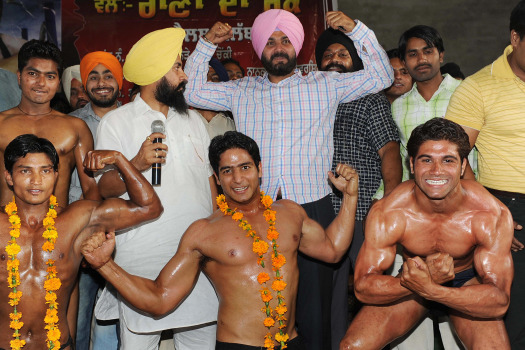 Published in 1954, AL Basham’s The Wonder That Was India is considered a classic in Indian historiography.
Published in 1954, AL Basham’s The Wonder That Was India is considered a classic in Indian historiography.
With a quick reworking of the title, it probably also reflects the Indian electorate’s choices. Here is one take coming from the prestigious Foreign Policy Passport Page.
Navjot Sidhu (in pink turban), Indian cricketer-turned-politician and member of Parliament for the right-wing nationalist Bharatiya Janata Party, flexes his muscles with bodybuilders during his campaign in the northern Indian city of Amritsar on April 26.
Sidhu is a colorful character on India’s political scene. The former cricketer won a seat in Parliament in 2004, resigned in 2006 after being convicted for manslaughter in connection with a 1988 parking dispute, and won back his seat in 2007 after the Supreme Court stayed the conviction. Unfortunately, criminality among Indian politicians isn’t especially unique. Of the 543 politicians returned to the lower house of Parliament in the last election in 2004, 128 had charges against them, including 84 with murder charges.[emphasis added]
Happy voting!
Many of you will fondly remember Rohanpreet’s performance on Zee TV last year. In similar news, here is Rashpal Kaur – a young girl from Chandigarh – who recently performed Gatka on Zee TVs Dance India Dance. The judges were not only taken aback by her performance, but also by the adversity she had experienced. Rashpal discovered that she had a life threatening brain tumor when she was pregnant. The treatment she received took away her vision but she was able to deliver a healthy baby boy.
“I only wished that I could see my son once. I just ask God to lend me my eye sight back for just for three hours so that I can see my child just once,” Rashpal said. But this is one wish that has never got fulfilled for Rashpal. [link]
As an ancient martial art, Gatka is considered a spiritual as well as physical exercise. I was impressed with what Gatka meant to Rashpal,
I’m thankful to Dance India Dance for helping me to reach out to so many people. The citizens have shown so much concern and care for me. Before I die I want to do something for my guru Kuljeet-ji and his martial arts school where he teaches young girls about self defense. In today’s times when women are being molested and victimized every other day, I want all the women to learn this martial art form to defend themselves and their dignity.” [link]
It’s an inspiring example of how one can turn pain into something much more powerful. You can view Rashpal’s performance after the jump.
 Next month marks the two year anniversary since the Shahadat of Bhai Kamaljit Singh. It has been quite some time since I last blogged about Dehra Sacha Sauda and unfortunately maybe I am also guilty of only following the story as the Indian media does or does not.
Next month marks the two year anniversary since the Shahadat of Bhai Kamaljit Singh. It has been quite some time since I last blogged about Dehra Sacha Sauda and unfortunately maybe I am also guilty of only following the story as the Indian media does or does not.
It was at the end of 2007, when this blog was first starting out, when I wrote about the ‘Sikh Successes of 2007’ with the incident of the confrontation of Dehra Sacha Sauda as #1 on my list. This week, I read an interesting synthesis by two French graduate students – Lionel Baixas et Charlène Simon. Lionel is completing his PhD in political science and is interested in democracy in South Asia, while Charlène is finishing her PhD in anthropology and has worked on issues related to the Ravidassia religious movement.
While I have commented on some of these issues, their recent article, titled “From Protesters to Martyrs: How to Become a ‘True’ Sikh” re-evaluates the Dehra Sacha Sauda issue through interviews and fieldwork conducted last April in Punjab and Haryana. Their abstract is as follows:
This article studies the protest which started in Punjab in May 2007 following a ceremony performed by Baba Gurmeet Ram Raheem Singh (GRRS), head of Dera Sacha Sauda, which was considered as blasphemous by a section of the Sikh community. The aim of this article is to understand the motivation of the actors of the protest itself: How did the Sikh protesters legitimate their reaction one year later? What kinds of reasons have led hundreds of Sikhs from very different social background to take the streets? What kind of emotions played a role in the Sikhs’ mobilization?
 Earlier this month, worldwide Human Rights organization Amnesty International released a news article on the plight of Sikh Massacre victims of 1984, still awaiting justice after 25 years. This came shortly after the Delhi Court delayed ruling on Jagdish Tytler, due to the CBI’s inability to produce enough evidence against him. Ramesh Gopalakrishnan, Amnesty International’s South Asia Researcher stated:
Earlier this month, worldwide Human Rights organization Amnesty International released a news article on the plight of Sikh Massacre victims of 1984, still awaiting justice after 25 years. This came shortly after the Delhi Court delayed ruling on Jagdish Tytler, due to the CBI’s inability to produce enough evidence against him. Ramesh Gopalakrishnan, Amnesty International’s South Asia Researcher stated:
“The fact that almost 3,000 people can be murdered without anyone being brought to justice is offensive to any notion of justice and should be an embarrassment to the Indian government.”
“For the Indian government to dismiss these cases due to lack of evidence is farcical. The various agencies responsible for carrying out the investigations failed to carry out the most cursory of tasks – including recording eyewitness and survivor statements.”
As troubling as it is to read this, I was pleased to find that Amnesty International had covered it at all. As many of know, AI, as well as other independent human rights groups and initiatives were either banned or prevented from conducting research in India in the late 1980’s and early 1990’s. It seems as though there is hope for an independent investigation on the 1984 anti-Sikh pogroms and perhaps the subsequent disappearances during the counter-insurgency.
Not so fast…in an un-related story, the Tribune reported that Amnesty International has decided to shut down its India operations. The decision is said to have been triggered by continued denial to the Amnesty International Foundation of the FCRA (Foreign Contribution Regulation Act) registration by the Government of India.
Continue Reading »
Blogged: Amol Singh
 On the night of April 24, 1915, over 200 of Constantinople’s Armenian intellectual and civic leaders were taken from their homes and boarded upon trains headed eastward toward the city of Ankara. What followed over the next few months would be a concerted, systematic Ottoman project meant to eradicate the Armenian identity. Millions of Armenians, depicted by the state as dangerous Russian conspirators and hazardous to the security of the Ottoman Empire, were uprooted from their homes and marched across the Turkish desert. What transpired over the course of that summer was the raping, pillaging, and butchering of over a million people. Though the Ottoman forces might have failed in the complete liquidation of a people, genocide served as a near consolation prize.
On the night of April 24, 1915, over 200 of Constantinople’s Armenian intellectual and civic leaders were taken from their homes and boarded upon trains headed eastward toward the city of Ankara. What followed over the next few months would be a concerted, systematic Ottoman project meant to eradicate the Armenian identity. Millions of Armenians, depicted by the state as dangerous Russian conspirators and hazardous to the security of the Ottoman Empire, were uprooted from their homes and marched across the Turkish desert. What transpired over the course of that summer was the raping, pillaging, and butchering of over a million people. Though the Ottoman forces might have failed in the complete liquidation of a people, genocide served as a near consolation prize.
As April 24th approaches, Armenians around the world will gather as they have for the past 90+ years and demand that the Turkish state take responsibility for its actions. This summer, as Sikhs also embark on projects to mark the events of 1984, it seems hard to escape the fact that we too, are becoming part of a global collective searching for some sort of acceptance of the atrocities that have been done to us. This sharing of spaces by the world’s downtrodden is allowing for more nuanced perspectives of each atrocity. In this understanding, the 1915 Armenian genocide becomes not a yearlong campaign to annihilate Armenia, but rather a set of events concurrent with a larger Ottoman decades- long campaign meant to undermine Armenian existence. In this sphere, Operation Blue Star becomes not a plan to rid Harimander Sahib of radicals hijacking the Sikh identity, but rather another incident in a set of systematic attacks on Sikh sovereignty by the Indian Center.
In this mold, we are becoming participants in a unique Genocidees Anonymous of sorts, where the recognition of our tragedies becomes cast into a set of layered political demands.
According to the Sikh Times, Sikh police officers are coming together to help address discrimination within the workforce in addition to addressing community relations between Sikhs and the British police.
The Association, which is to launch next Wednesday, lists its goals as follows:
The aims and objectives of the BPSA are;
- To establish a national forum for Sikh members of the British police services
- To assist the British police services in developing strategies to recruit, retain, and progress Sikh members of the service hence increasing Sikh representation in the police service at all levels
- To provide a religious, cultural and social forum for members of the BSPA through celebration of dates and festivals on the Sikh calendar.
- To promote an understanding of the Sikh Faith and the Sikh values of democracy, equality and justice within the police services
- To provide support and advice to Sikh members of the police service.
- To promote social cohesion and integration.
It seems like Canada is showcasing one socially conscious Sikh rapper after another. TLH has covered “Humble The Poet” and now here is “Sikh Knowledge” from Montreal. Sikh Knowledge raps with Lotus on issues effecting the 2nd generation and marginalized peoples.
Kanwar Anit Singh Saini, a.k.a. Sikh Knowledge, is the son of Punjabi Sikh immigrants. He works in the field of speech pathology where he contributes his musical knowledge to the health sciences field.
Check out his songs below and let us know what you think!
Disclaimer: There are graphic descriptions and swear words in the videos below.
 Sometimes some articles are too disturbing to not make a comment.
Sometimes some articles are too disturbing to not make a comment.
The word Mein Kampf immediately brings to mind Adolf Hitler’s deluded dream and genocidal paranoia of the “Jewish peril”. Long the Bible of idiotic Aryan supremacist groups, the book seems to have found a rather new (or maybe) old niche market in India.
Sales of Mein Kampf, Adolf Hitler’s autobiography and apologia for his anti-semitism, are soaring in India where business students regard the dictator as a management guru.
Booksellers told The Daily Telegraph that while it is regarded in most countries as a ‘Nazi Bible’, in India it is considered a management guide in the mould of Spencer Johnson’s “Who Moved My Cheese”.
Sales of the book over the last six months topped 10,000 in New Delhi alone, according to leading stores, who said it appeared to be becoming more popular with every year.
On TLH we have posted on the importance of Punjabi/Khalsa Schools. I have found that despite many students’ resistance to attend these schools, they plant the seeds for future exploration into Sikhi. At the age of 12 you may think you are too cool for school on Sundays, but at 19-20 or even 30 that experience creates a base for you to delve more deeply into your spiritual identity. Thus, I think it is extremely important that each Sikh community have at least one good Punjabi/Khalsa school. Ideally, I would want each Gurdwara to have one.
However, Punjabi/Khalsa Schools run into problems because in some way or another they become linked with communal politics. Most often this politics infiltrates schools within Gurdwaras. I think a fundamental component of a Gurdwara is a Punjabi/Khalsa School as is a Langar Hall. However, for many Gurdwaras, Punjabi/Khalsa Schools are a last priority. Gurdwara committees will fund new kitchen appliances before making a commitment to continually fund a Punjabi/Khalsa School. Thus, some community members have decided to create Punjabi/Khalsa Schools outside of the Gurdwara in local community-centers. When I hear this, I am both excited and disappointed. Excited that a school has been established; but disappointed that we are showing Sikh youth that we have to step outside of our main institution, the Gurdwara. How are we supposed to socialize our children into a Gurdwara-going culture when our leadership doesn’t support it in action? It’s a Catch 22. I don’t blame community members for creating schools outside of the Gurdwara. Their circumstances are real and, many times, this is their only feasible option. Or is it?
